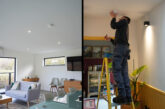
Martyn Walley, National Technical Manager at Aico, looks at why installers need not be overwhelmed by the latest technological advancements in smoke alarms.
Are you of the age to remember when a phone was just that: a phone? Then came text messaging and that was OK. Then you could take pictures with your phone… and get directions… and access the internet… and pay for things… and control your heating at home… and so the list goes on. If you’re of a certain generation, making a call is now one of the last things you actually use your phone for!
Advanced technology is seeping into all electronic devices, including those in the trade sector. A domestic smoke alarm still performs its fundamental life-saving task of detecting smoke, but now comes with a host of added features and functions designed to further enhance the safety of residents whilst adding flexibility into a system. However, such features are only beneficial if you truly understand their purpose, how to fit/apply them and how to use them.
For some installers the array of different smoke alarm features and functionality can seem overwhelming. Gone are the days when you simply had to decide which alarm sensor type – ionisation, optical or heat – to use and where. Now multi-sensors have been added to the mix, along with accessories such as alarm controllers and interfaces to third party life safety systems. You need to decide how to interconnect these alarms and devices, be it hard-wired or wire-free. And that’s just the beginning!
This is where manufacturers have an important role to play. Firstly, they must ensure the technology incorporated into modern day smoke alarms is easy to understand, install and use. Secondly, they should provide support, training and product information in multiple formats, so that you can pick one that fits with your work schedule.
Technology should be simple
Let’s start with the key technological developments in smoke alarms over recent years and what manufacturers have done to make them intuitive or, at the very least, easy to use.
Wire-free alarm interconnection has arguably had the biggest impact in the domestic smoke alarm sector. BS 5839-6 and Building Regulations require fire alarms to be interconnected. Hard-wiring alarms together can be effective in a new build property, but it creates significant disruption and cosmetic damage in existing properties. Instead this can be achieved using Radio Frequency (RF) signals.
As you’d expect, installing alarms with wireless interconnection is quick and simple, but only if there’s a straightforward way to get these alarms to ‘talk’ to each other via the RF signals. Ideally this should be achieved at the push of a button on the alarm, as is the case with our very own RadioLINK+ RF system.
With alarm interconnection made easy, quick and cost-effective, systems are growing in size. System expansion brings its own set of issues, however, including how best to control them. With a large system it takes longer to test individual alarms and identify which alarm has triggered. Test, Silence and Locate switches are an important consideration here, so make sure the system you use offers one in its range. It enables the resident to test and silence all the alarms on the system from the one conveniently placed switch as well as allowing for quick identification of the unit that has caused the alarm.
RF technology has resulted in other benefits, most notably the ability to interconnect a smoke alarm system to other life saving devices and systems, including Carbon Monoxide (CO) Alarms, Telecare/Warden call systems, sprinkler systems and BS5839 Part 1 panel based fire alarm systems. This sounds like it has the potential to be complicated, so what should you be looking for to ensure it isn’t?
Traditional relays make it possible to link domestic alarms to such devices, but as they do not contain the software and multiple inputs/outputs that are needed specifically for these applications your options are limited. Instead look for a smoke alarm system that provides a dedicated device that has been specifically designed and tested for this exact purpose, such as the Aico Ei414 Fire/CO Alarm Interface. Devices such as these are not only reliable and easy to install but often come with added features, such as a ‘Test’ setting to test the entire system, including a signal being transmitted to the third party system.
One of the newest technologies to be launched is data extraction from alarms. This phrase sounds complicated and seems inherently linked to IT, requiring a degree in computer engineering. But fear not as data extraction technology has genuine benefits to offer, including information on battery back-up or battery life, alarm sensor status, number of times tested and removed and any alarm activation with details of when it occurred.
In the past data extraction has required specialist equipment or the removal of the alarm from the property, but all that has changed. With the latest generation of smoke and CO alarms, data can be extracted on-site, in real time, all without taking the alarm off the ceiling. Furthermore, it doesn’t have to be complex. Take Aico’s award-winning AudioLINK for example, which allows data to be extracted via the alarm’s sounder using a free AudioLINK App. The App turns the data into an easy-to-digest graphics-based report, colour-coded to identify the urgency of any issue and, in some cases, what action to take next. It’s a prime example of sophisticated technology made simple for the user.
Training – when you want it, how you want it
Regardless of how easy to use smoke alarm manufacturers make their technology, training is always beneficial.
In our experience contractors are willing to commit to training as it’s understood that they’re dealing with potentially life saving devices and want to provide customers with an effective system. Plus it makes good business sense.
However, the old adage ‘time is money’ really does apply here. Time taken off to learn about a product means time away from work so the training has to be delivered in a suitable way. This could mean modular, bite-sized training so it can be taken over a longer period of time. Deliverability of that training is also a consideration. Online training may be an option, but it’s limited and not very engaging; nothing can really beat face-to-face, hands-on training sessions. Aico’s Expert Installer is a free of charge CPD accredited training scheme created to ensure everyone involved in domestic alarm installation has all the information they need, from standards & regulations, alarm system design & installation, through to specific technologies. Expert Installer training can be held at customers’ premises, at Aico’s Centre of Excellence in Shropshire or in one of Aico’s new Mobile Training & Demonstration Units. Flexibility is key.
Embrace technology
It’s safe to say we’re living through times of great technological change with the potential to make positive differences to our everyday lives. Even in the smoke alarm industry, never before has there been so much choice and so many feature-rich alarms. But pick wisely; the latest alarm technology shouldn’t be difficult to understand if the manufacturer has played its part.
For more information about Aico’s range of smoke alarms visit: https://www.aico.co.uk/











